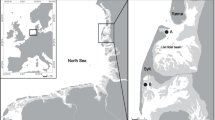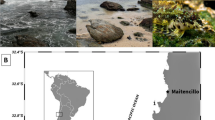Abstract
Sedimentation is an important stressor of coastal ecosystems; yet, there is little research into specific mechanisms by which populations are affected by additional sediment loads resulting from anthropogenic-driven processes. This study explored the potential impact of the proposed disposal of over 7 million m3 of dredge spoil on a nearby fishery for the blackfoot abalone Haliotis iris. The range of sediment deposition predicted by models to occur on reefs inhabited by H. iris as a result of the dispersal of sediment from the disposal site was used to design controlled experiments between July and September 2011 to test the likely effects of sedimentation on: (a) behaviour and mortality of juvenile H. iris and (b) photosynthetic vitality of crustose coralline algae (CCA) that form nursery habitats for H. iris obtained from Brinns Point (45, 40.3′S, 170, 39.4′E). We observed no direct effects on the health or mortality of H. iris juveniles or the photosynthetic vitality of habitat forming CCA. H. iris did, however, avoid sediments by moving from predation refugia beneath cobbles to vertical surfaces on cobble edges significantly more often in sediment treatments compared to sediment-free controls. Deposited sediments were also found to inhibit righting response, key behaviour in allowing H. iris to reattach to the substratum following dislodgement. Results of this study suggest that indirect mortality from reductions in available refugia from predation and inability to recover from dislodgement could be significant. These results highlight the importance of understanding indirect impacts of stressors on key ecological processes in order to predict ecological responses.




Similar content being viewed by others
References
Aguirre JD, McNaught DC (2010) Habitat modification affects recruitment of abalone in central New Zealand. Mar Biol 158(3):505–513
Aguirre-Davies JD (2006) Early life ecology of Haliotis iris: The effects of algal habitat, depth and substrate complexity on recruitment. Victoria University of Wellington, Wellington, Master thesis
Airoldi L (2003) The effects of sedimentation on rocky shore assemblages. Oceanogr Mar Biol Annu Rev 41:161–236
Airoldi L, Cinelli F (1997) Effects of sedimentation on subtidal macroalgal assemblages: an experimental study from a Mediterranean rocky shore. J Exp Mar Biol Ecol 215:269–288
Airoldi LH, Hawkins SJ (2007) Negative effects of sediment deposition on grazing activity and survival of the limpet Patella vulgata. Mar Ecol Prog Ser 332:235–240
Airoldi L, Virgilio M (1998) Responses of turf-forming algae to spatial variations in the deposition of sediments. Mar Ecol Prog Ser 165:271–282
Alcock N and Grange K in conjunction with Ngati Koata iwi authority (2002) Procedures for the transfer of pāua, with special reference to Taiāpure and mahinga mataitai areas. NIWA Information Series No. 27
Andrew N and Naylor R (2003) Pāua. In: Andrew N and Francis M (eds) The living reef: ecology of New Zealand’s rocky reefs. Craig Potton Publishing, Auckland:114-119
Bjork M, Mohammed SM, Bjorklund M, Semesi A (1995) Coralline algae, important coral-reef builders threatened by pollution. Royal Swedish Academy of Sciences 24(7):502–505
Boyd RO (2008) Fisheries resources in Otago Harbour and on the adjacent coast. Report prepared for Port Otago Ltd., Boyd Fisheries Consultants Ltd., Wanaka
Closs G, Downes B, Boulton A (2004) Freshwater ecology: a scientific introduction. Wiley-Blackwell, Oxford, pp 75–138
Connell JH (1985) The consequences of variation in initial settlement vs. post settlement mortality in rocky intertidal communities. J Exp Mar Biol Ecol 93:11–45
Connell SD (2005) Assembly and maintenance of subtidal habitat heterogeneity: synergistic effects of light penetration and sedimentation. Mar Ecol Prog Ser 289:53–61
de Waal SWP, Branch GM, Navarro R (2003) Interpreting evidence of dispersal by Haliotis midae juveniles seeded in the wild. Aquaculture 221:299–310
Diggles BK and National Institute of Water and Atmospheric Research (NZ) (2002) A handbook of diseases of importance to aquaculture in New Zealand. Wellington, NIWA
Donovan D, Baldwin J, Carefoot T (1999) The contribution of anaerobic energy to gastropod crawling and a re-estimation of minimum cost of transport in the abalone, Haliotis kamtschatkana (Jonas). J Exp Mar Biol Ecol 235:273–284
Fabricius K, De’ath G (2001) Environmental factors associated with the distribution of crustose coralline algae on the Great Barrier Reef. Coral Reefs 19:303–309
Garibaldi A, Turner N (2004) Cultural keystone species: implications for ecological conservation and restoration. Ecol Soc 9:1–18
GESAMP (1993) Anthropogenic influences on sediment discharge to the coastal zone and environmental consequences. Rep Stud GESAMP 52, UNESCO, Paris
Harrington L, Fabricius K, Eaglesham G, Negri A (2005) Synergistic effects of diuron and sedimentation on photosynthesis and survival of crustose coralline algae. Mar Pollut Bull 51:415–427
Heinz Walz GmbH (1998) Underwater fluorometer Diving-PAM: submersible photosynthesis yield analyzer’, handbook of operation. Effeltrich, Germany
Hopkins WG, Hüner NPA (1999) Introduction to plant physiology, 3rd edn. John Wiley and Sons, Western Ontario, pp 482–484
James M, Boyd R and Probert K (2010) Information on key species of interest to Ngai Tahu—supplementary paper for Next Generation Project. Port Otago Ltd
Kregting LT, Hepburn CD, Hurd CL, Pilditch CA (2008) Seasonal Patterns of Growth and Nutrient Status of the Macroalga Adamsiella Chauvinii (Rhodophyta) in Soft Sediment Environments. J Exp Mar Biol Ecol 360(2):94–102
Kyle R (2012) The abundance, diet and ecology of the sea star Astrostole scabra in the East Otago Taiapure. Masters thesis, University of Otago, Dunedin
McShane PE, Naylor R (1996) Variation in spawning and recruitment of Haliotis iris (Mollusca: Gastropoda). N Z J Mar Freshw Res 30:325–332
Miller S, Hicks M, Dickson M, Walker J (2007) Muddy waters at Te Māhia: cause and effect. Water & Atmosphere 15(4):20–21
Minchin D (1975) The righting response in Haliotids. The Veliger 17(3):249–251
Morrison MA, Lowe ML, Parsons DM, Usmar NR and McLeod IM (2009) A review of land-based effects on coastal fisheries and supporting biodiversity in New Zealand. New Zealand aquatic environment and biodiversity Report No. 37, Ministry of fisheries, Wellington
Naylor R, Neill K, Stewart R (2006) Coralline algae and pāua settlement. Water & Atmosphere 14(2):14–15
Newcombe CP, MacDonald DD (1991) Effects of suspended sediments on aquatic ecosystems. North Am J Fish Manage 11(1):72–82
Onitsuka T, Kawamura T, Ohashi S, Iwanaga S, Horii T, Watanabe Y (2008) Effects of sediments on larval settlement of abalone Haliotis diversicolor. J Exp Mar Biol Ecol 365:53–58
Philipp E, Fabricius K (2003) Photophysiological stress in scleractinian corals in response to short-term sedimentation. J Exp Mar Biol Ecol 287:57–78
Phillips NE, Shima JS (2006) Differential effects of suspended sediments on larval survival and settlement of New Zealand urchins Evechinus chloroticus and abalone Haliotis iris. Mar Ecol Prog Ser 314:149–158
McCarthy A, Hepburn C.D, Scott N., Kschweikert K, Turner R, Moller H. Local people see and care most? Severe depletion of inshore fisheries and its consequences for Māori communities in New Zealand. (in review) Aquat Conserv: Mar Freshwat Ecosyst
Port Otago Ltd. (2010) Project Next Generation resource consent applications and assessment of environmental effects. http://www.portotago.co.nz/8/3.html. Accessed 28 July 2012
Preece MA (1998) Growth, mortality, and sensory qualities of black foot pāua (Haliotis iris). University of Otago, Dunedin, Master thesis
Prince J (2005) Combating the tyranny of scale for haliotids: micro-management for microstocks. B Mar Sci 76:557–577
Rogers CS (1990) Responses of coral reefs and reef organisms to sedimentation. J Exp Mar Biol Ecol 62:185–202
Sainsbury KJ (1982) Population dynamics and fishery management of the pāua, Haliotis iris I. Population structure, growth, reproduction, and mortality. N Z J Mar Freshw Res 16:147–161
Schiel DR (1993) Experimental evaluation of commercial-scale enhancement of abalone Haliotis iris population in New Zealand. Mar Ecol Prog Ser 97:167–181
Schiel DR, Welden BC (1987) Responses to predators of cultured and wild red abalone, Haliotis rufescens, in laboratory experiments. Aquaculture 60:173–188
Schiel DR, Wood SA, Dunmore RA, Taylor DI (2006) Sedimentation on rocky intertidal reefs: effects on early post-settlement stages of habitat-forming seaweeds. J Exp Mar Biol Ecol 331:158–172
Schreiber U, Schliwa U, Bilger W (1986) Continuous recording of photochemical and non-photochemical chlorophyll fluorescence quenching with a new type of modulation fluorometer. Photosynth Res 10:51–62
Seafood Industry Council (2012) Exports of Seafood Produce for 12 months ending December 2011. NZ SeaFIC. http://www.seafoodindustry.co.nz/f403,20467/20467_Exports_of_seafood_2010_and_2011.pdf. Accessed 4 Sep 2012
Shepherd SA (1973) Studies on southern Australian abalone (genus Haliotis) I. Ecology of five sympatric species. Aust J Mar Fresh Res 24:217–257
Shepherd SA (1998) Studies on southern Australian abalone (genus Haliotis) XIX. Long-term juvenile mortality dynamics. J Shellfish Res 17:813–825
Shepherd SA, Cannon J (1988) Studies on southern Australian abalone (genus Haliotis) X. Food and feeding of juveniles. J Malacol Soc Aust 9:21–26
Shepherd SA, Turner JA (1985) Studies on South Australian Abalone (Genus Haliotis). VI. Habitat preference, abundance and predators of juveniles. J Exp Mar Biol Ecol 93:285–298
Single M, Bell R, McComb P (2010) Physical coastal environment of Otago Harbour and offshore: assessment of effects of proposed dredging by Port Otago Ltd. Shore Processes and Management Ltd, Christchurch
Sinutok S, Hill R, Doblin MA, Wuhrer R, Ralph PJ (2011) Warmer more acidic conditions cause decreased productivity and calcification in subtropical coral reef sediment-dwelling calcifiers. Limnol Oceanogr 56(4):1200–1212
Sousa WP (2001) Natural disturbance and the dynamics of marine benthic communities. In: Bertness MD, Gaines SD, Hay ME (eds) Marine community ecology. Sinauer Associates, Sunderland, Massachusetts
Steneck RS (1982) A limpet coralline alga association: adaptations and defences between a selective herbivore and its prey. Ecology 63:507–522
Steneck RS (1997) Crustose corallines, other algal functional groups, herbivores and sediment: complex interactions along reef productivity gradients. In: Proceedings from the 8th International Coral Reef Symposium 1: 695–700
Strain EMA, Johnson CR (2010) Scale-dependent relationships between benthic habitat characteristics and abundances of blacklip abalone, Haliotis rubra (Leach). Mar Freshw Res 61:1227–1236
Tutschulte TC, Connell JH (1988) Feeding behaviour and algal food of three species of abalones (Haliotis) in southern California. Mar Ecol Prog Ser 49:57–64
Valentine JP, Tarbath D, Frusher SD, Mundy CN, Buxton CD (2010) Limited evidence for ecosystem-level change on reefs exposed to Haliotis rubra (‘blacklip abalone’) exploitation. Austral Ecol 35:1–13
Walker TW (2007) Effects of fine sediments on settlement and survival of the sea urchin Evechinus chloroticus in northeastern New Zealand. Mar Ecol Prog Ser 331:109–118
Wang GJ, Xie J Yu DG, Wu L and Hu ZY (2007) Physiological responses of abalone Haliotis diversicolor to suspended sediment stress. J Dalian Fish Coll 5, Abstract only. http://en.cnki.com.cn/Article_en/CJFDTOTAL-DLSC200705008.htm. Accessed 16 Sep 2011
Zar JH (1996) Biostatistical analysis, 3rd edn. Prentice Hall, New Jersey
Acknowledgments
The authors would like to acknowledge the East Otago Taiāpure Management Committee for their knowledge, the University of Otago Portobello Marine Laboratory for laboratory space and access to field equipment, Dr. Stephen Wing for advice on experimental design and two anonymous reviewers for their input. We would like to thank Rory Kyle for field assistance and Reuben Pooley, Matt Baird, Megan Bedford, Chris Cornwall and Alex Ghaemaghamy for laboratory assistance. Support was provided through Te Tiaki Mahinga Kai programme funded by MBIE Te Tipu o te Wananga Grant Number UOOX0608.
Author information
Authors and Affiliations
Corresponding author
Additional information
Communicated by S. Connell.
Rights and permissions
About this article
Cite this article
Chew, C.A., Hepburn, C.D. & Stephenson, W. Low-level sedimentation modifies behaviour in juvenile Haliotis iris and may affect their vulnerability to predation. Mar Biol 160, 1213–1221 (2013). https://doi.org/10.1007/s00227-013-2173-0
Received:
Accepted:
Published:
Issue Date:
DOI: https://doi.org/10.1007/s00227-013-2173-0




